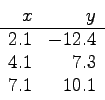Ceng 375 Numerical Computing
Midterm
Nov 16, 2005 10.40-12.30
Good Luck!
1 (20 Pts)
- i
- Under what conditions can parallel processing not be used to speed up a computation?
- ii
- How many iterations of bisection will be required to attain an accuracy of
 if the starting interval is
if the starting interval is ![$[a,b]$](img2.png) ?
?
2 (20 Pts) The function
 has values of zero near
has values of zero near  and
and  .
.
- iii
- What is the derivative of
 ?
?
- iv
- If you begin Newton's method at
 , which root is reached? How many iterations to achieve an error less than
, which root is reached? How many iterations to achieve an error less than  ?
?
3 (20 Pts) Solve this system by Gaussian elimination with pivoting
- v
- How many row interchanges are needed?
- vi
- Repeat without any row interchanges. Do you get the same results?
- vii
- You could have saved the row multipliers and obtained a
 equivalent of the coefficient matrix. Use this
equivalent of the coefficient matrix. Use this  to solve but with right-hand sides of
to solve but with right-hand sides of ![$[-3,7,-2]^T$](img11.png)
- viii
- Solve the second item again but use only three significant digits of precision.
4 (20 Pts) Consider the linear system
- ix
- Solve this system with the Jacobi method. First rearrange to make it dioganally dominant if possible. Use
![$[0,0,0]$](img13.png) as the starting vector.
as the starting vector.
- x
- Repeat with Gauss-Seidel method. Compare with Jacobi method.
5 (20 Pts)
For the given data points;
- Write out the Lagrangian polynomial from this table
- xi
- confirm that it reproduces the
 's for each
's for each  -value.
-value.
- xii
- interpolate with it to estimate
 at
at  .
.
- xiii
- extrapolate with it to estimate
 at
at  .
.
- Suppose in previous item that the
 -value for
-value for  is mistakenly entered as
is mistakenly entered as  rather than
rather than  . Repeat the previous item with this incorrect value. How much difference does this make?
. Repeat the previous item with this incorrect value. How much difference does this make?
- Expand the Lagrangian polynomials in the previous items to get the quadratics in the form
 . How different are the values for
. How different are the values for  ,
, , and
, and  ?
?
6 (20 Pts) For the given data points;
- xiv
- construct the divided-difference table.
- xv
- interpolate for
 .
.
- xvi
- extrapolate for
 .
.
2006-09-28
![\begin{displaymath}
\left[
\begin{array}{rrrr}
1 &-2 &4&6\\
8 &-3 &2&2\\
-1 &10 &2&4\\
\end{array} \right]
\end{displaymath}](img9.png)


